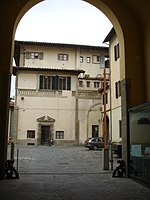Museo Nazionale di San Marco

Museo Nazionale di San Marco is an art museum housed in the monumental section of the medieval Dominican convent of San Marco dedicated to St Mark, situated on the present-day Piazza San Marco, in Florence, a region of Tuscany, Italy. The museum, a masterpiece in its own right by the fifteenth-century architect Michelozzo, is a building of first historical importance for the city and contains the most extensive collection in the world of the works of Fra Angelico, who spent several years of his life there as a member of the Dominican community. The works are both paintings on wood and frescoes. The museum also contains other works by artists such as Fra Bartolomeo, Domenico Ghirlandaio, Alesso Baldovinetti, Jacopo Vignali, Bernardino Poccetti and Giovanni Antonio Sogliani. San Marco is known as the seat of Girolamo Savonarola's discourses during his short spiritual rule in Florence in the late 15th century. Also housed at the convent is a famous collection of manuscripts in a library built by Michelozzo.
Excerpt from the Wikipedia article Museo Nazionale di San Marco (License: CC BY-SA 3.0, Authors, Images).Museo Nazionale di San Marco
Via Giorgio La Pira, Florence Quartiere 1
Geographical coordinates (GPS) Address External links Nearby Places Show on map
Geographical coordinates (GPS)
| Latitude | Longitude |
|---|---|
| N 43.778198 ° | E 11.259329 ° |
Address
Convento di San Marco
Via Giorgio La Pira
50112 Florence, Quartiere 1
Tuscany, Italy
Open on Google Maps










